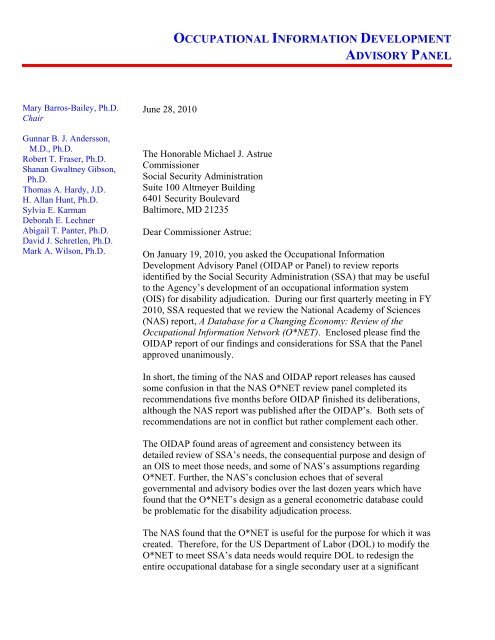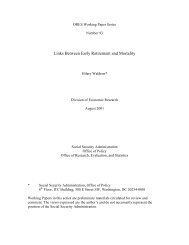occupational information development advisory panel - Social Security
occupational information development advisory panel - Social Security
occupational information development advisory panel - Social Security
Create successful ePaper yourself
Turn your PDF publications into a flip-book with our unique Google optimized e-Paper software.
OCCUPATIONAL INFORMATION DEVELOPMENTADVISORY PANELMary Barros-Bailey, Ph.D.ChairGunnar B. J. Andersson,M.D., Ph.D.Robert T. Fraser, Ph.D.Shanan Gwaltney Gibson,Ph.D.Thomas A. Hardy, J.D.H. Allan Hunt, Ph.D.Sylvia E. KarmanDeborah E. LechnerAbigail T. Panter, Ph.D.David J. Schretlen, Ph.D.Mark A. Wilson, Ph.D.June 28, 2010The Honorable Michael J. AstrueCommissioner<strong>Social</strong> <strong>Security</strong> AdministrationSuite 100 Altmeyer Building6401 <strong>Security</strong> BoulevardBaltimore, MD 21235Dear Commissioner Astrue:On January 19, 2010, you asked the Occupational InformationDevelopment Advisory Panel (OIDAP or Panel) to review reportsidentified by the <strong>Social</strong> <strong>Security</strong> Administration (SSA) that may be usefulto the Agency’s <strong>development</strong> of an <strong>occupational</strong> <strong>information</strong> system(OIS) for disability adjudication. During our first quarterly meeting in FY2010, SSA requested that we review the National Academy of Sciences(NAS) report, A Database for a Changing Economy: Review of theOccupational Information Network (O*NET). Enclosed please find theOIDAP report of our findings and considerations for SSA that the Panelapproved unanimously.In short, the timing of the NAS and OIDAP report releases has causedsome confusion in that the NAS O*NET review <strong>panel</strong> completed itsrecommendations five months before OIDAP finished its deliberations,although the NAS report was published after the OIDAP’s. Both sets ofrecommendations are not in conflict but rather complement each other.The OIDAP found areas of agreement and consistency between itsdetailed review of SSA’s needs, the consequential purpose and design ofan OIS to meet those needs, and some of NAS’s assumptions regardingO*NET. Further, the NAS’s conclusion echoes that of severalgovernmental and <strong>advisory</strong> bodies over the last dozen years which havefound that the O*NET’s design as a general econometric database couldbe problematic for the disability adjudication process.The NAS found that the O*NET is useful for the purpose for which it wascreated. Therefore, for the US Department of Labor (DOL) to modify theO*NET to meet SSA’s data needs would require DOL to redesign theentire <strong>occupational</strong> database for a single secondary user at a significant
Michael J. Astrue, CommissionerJune 28, 2010Page 2cost to taxpayers and, in the process, potentially forsake a primaryworkforce <strong>development</strong> purpose for which it was created.Our review of the NAS report affirms the recommendations outlined inour September 30, 2009 report. In addition, the O*NET report providesinsights and useful <strong>information</strong> that we have suggested as areas for SSA’sconsideration. Specifically, the OIDAP advises caution in advancing anaggressive research agenda for the OIS before the internal scientificexpertise unit is established or risk scientific rigor in the process of theOIS’s <strong>development</strong>. We further strongly support the ongoing cooperationbetween SSA and DOL, as well as with other government agencies, whichwill best serve each agency and the American public. Lastly, we raiseethical and legal concerns regarding pressures to update the Dictionary ofOccupational Titles (DOT) or to repurpose the O*NET withoutrevalidating the database vis-à-vis disability needs. Indeed, weconsidered the best of both systems in our recommendations and thechanges conceptualized for either system by definition result in the<strong>development</strong> of a new system for SSA.As you know, the OIDAP extended the public feedback period throughJune 30, 2010 to accommodate the use of the Federal Register notice tosolicit comments. Although we welcome input from stakeholders and thepublic at any time, once the formal feedback period closes, the OIDAPwill provide you with an overview of the comments received since weissued our recommendations last year.On behalf of the members of the OIDAP, thank you for your commitmentto develop an OIS specific to SSA’s disability programs. As you know,the Panel voted unanimously in 2009 that a new OIS was needed toreplace the DOT in these programs. From the Panel’s perspective, thedeveloping a new OIS appears to be a mandatory project for SSA. As theDOT ages, SSA may soon find itself without a defensible framework fordisability adjudication. The resulting ramifications to people withdisabilities and to the American society are as serious as the potentialsocial, time, and monetary costs could be staggering.Sincerely,Mary Barros-BaileyMary Barros-Bailey, PhDChair6401 <strong>Security</strong> Boulevard, 3-E-26 OperationsBaltimore, MD 21235
Michael J. Astrue, CommissionerJune 28, 2010Page 3Enclosurecc:David RustMarianna LaCanforaRichard BalkusRobert WeathersSylvia E. KarmanPaul KryglikDebra Tidwell-Peters6401 <strong>Security</strong> Boulevard, 3-E-26 OperationsBaltimore, MD 21235








